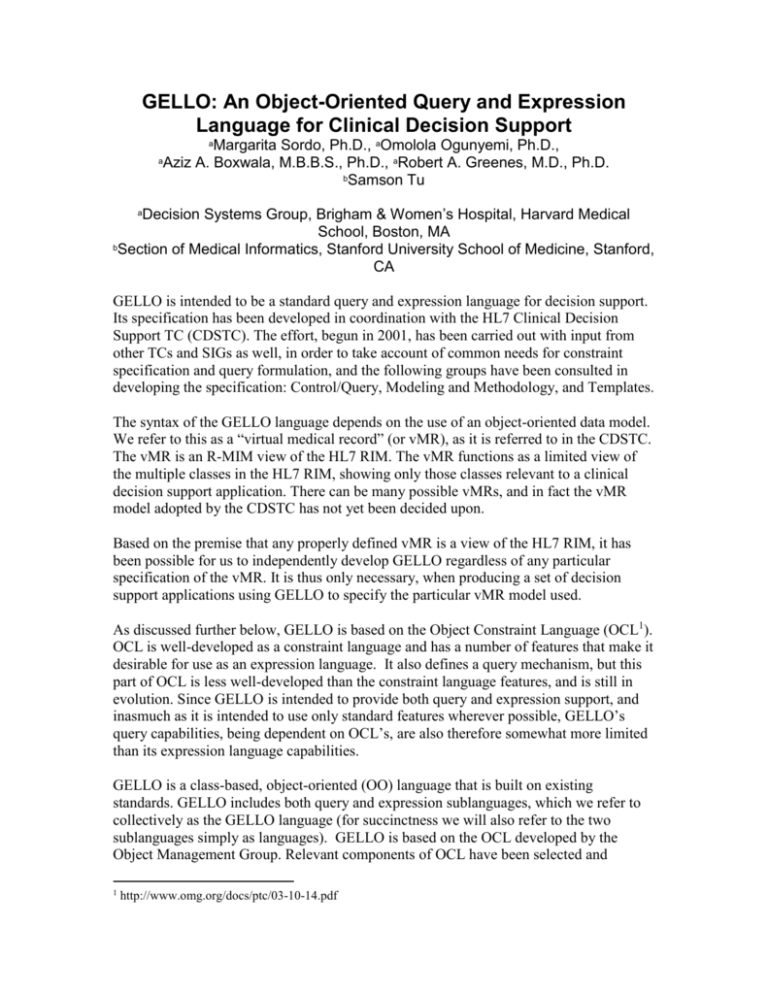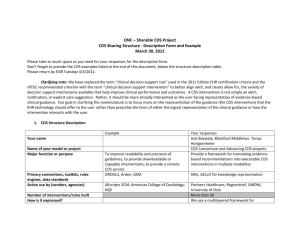GELLO: An Object-Oriented Query and Expression Language for
advertisement

GELLO: An Object-Oriented Query and Expression Language for Clinical Decision Support Margarita Sordo, Ph.D., aOmolola Ogunyemi, Ph.D., Aziz A. Boxwala, M.B.B.S., Ph.D., aRobert A. Greenes, M.D., Ph.D. bSamson Tu a a Decision Systems Group, Brigham & Women’s Hospital, Harvard Medical School, Boston, MA bSection of Medical Informatics, Stanford University School of Medicine, Stanford, CA a GELLO is intended to be a standard query and expression language for decision support. Its specification has been developed in coordination with the HL7 Clinical Decision Support TC (CDSTC). The effort, begun in 2001, has been carried out with input from other TCs and SIGs as well, in order to take account of common needs for constraint specification and query formulation, and the following groups have been consulted in developing the specification: Control/Query, Modeling and Methodology, and Templates. The syntax of the GELLO language depends on the use of an object-oriented data model. We refer to this as a “virtual medical record” (or vMR), as it is referred to in the CDSTC. The vMR is an R-MIM view of the HL7 RIM. The vMR functions as a limited view of the multiple classes in the HL7 RIM, showing only those classes relevant to a clinical decision support application. There can be many possible vMRs, and in fact the vMR model adopted by the CDSTC has not yet been decided upon. Based on the premise that any properly defined vMR is a view of the HL7 RIM, it has been possible for us to independently develop GELLO regardless of any particular specification of the vMR. It is thus only necessary, when producing a set of decision support applications using GELLO to specify the particular vMR model used. As discussed further below, GELLO is based on the Object Constraint Language (OCL1). OCL is well-developed as a constraint language and has a number of features that make it desirable for use as an expression language. It also defines a query mechanism, but this part of OCL is less well-developed than the constraint language features, and is still in evolution. Since GELLO is intended to provide both query and expression support, and inasmuch as it is intended to use only standard features wherever possible, GELLO’s query capabilities, being dependent on OCL’s, are also therefore somewhat more limited than its expression language capabilities. GELLO is a class-based, object-oriented (OO) language that is built on existing standards. GELLO includes both query and expression sublanguages, which we refer to collectively as the GELLO language (for succinctness we will also refer to the two sublanguages simply as languages). GELLO is based on the OCL developed by the Object Management Group. Relevant components of OCL have been selected and 1 http://www.omg.org/docs/ptc/03-10-14.pdf integrated into the GELLO query and expression languages to provide a suitable framework for manipulation of clinical data for decision support in health care. The GELLO language can be used to: Build up queries to extract and manipulate data from medical records. Construct decision criteria by building up expressions to reason about particular data features/values. These criteria can be used in decision-support knowledge bases such as those designed to provide alerts and reminders, guidelines, or other decision rules. Create expressions, formulae, and queries for other applications. The query and expression languages share a common OO data model since the expressions must operate on data supplied by queries. The query language has been designed in the context of a guideline execution model proposed in the HL7 CDSTC. This model proposes the use of a vMR that provides a standard interface to heterogeneous medical record systems. While the query language does not depend on the specific classes or tables in the vMR, it does rely on the general framework of the vMR. The expression language can be used for specifying decision criteria, and abstracting or deriving summary values. The object-oriented approach for the language has the flexibility and extensibility that is needed for implementation in a broad range of applications. The expression language is strongly typed and object-oriented. In order to facilitate the process of encoding and evaluation of expressions and more importantly, to maximize the ability to share such queries and expressions, GELLO includes basic built-in data types while providing the necessary mechanisms to access an underlying data model with all its associated classes and methods. This is especially important in enabling decision rules and guidelines to successfully support different data models, inasmuch as classes and relationships specified could vary from one data model to another. We propose GELLO as a platform-independent standard query and expression languages for sharing and manipulating knowledge in a medical context. Specifically: GELLO is targeted to clinical applications that need to use queries and expression languages for decision support. GELLO is vendor-independent by relying on a language specification that is not vendor-specific. GELLO is platform-independent in that the language can be implemented on various platforms. GELLO provides the mechanisms to access data through an OO data model, with strongly-typed expressions, via general purpose query and expression languages. GELLO is a declarative language. Its queries and expressions have no side effects. GELLO is extensible by adding new user-defined classes to the underlying OO data model. All data manipulation methods must be explicitly defined in the OO data model. The purpose of GELLO is to provide a robust syntax for queries and expressions so data can be easily handled. By using a specified OO data model, such as the vMR, each decision rule or guideline need not provide a separate mechanism for translation of data elements to/from host environments (e.g., the “curly braces” needed in the Arden Syntax data section). The object-oriented approach allows modularity, encapsulation and extensibility. Thus use of GELLO: 1. provides platform-independent support for mapping to the OO data model used (e.g., the vMR). Therefore it eliminates the need for curly braces or other implementation-specific encoding methods for information retrieval as part of knowledge content (guidelines, alerts, etc.). 2. simplifies the creation and updating of clinical data objects, and their evaluation. 3. facilitates sharing of decision logic and other computer expressions. Figure 1: GELLO and its relation to Arden Syntax, GLIF, RIM and other DSs and KBs. GELLO query and expression languages can be embedded into various tools to provide the mechanisms for access and manipulation of OO data.





